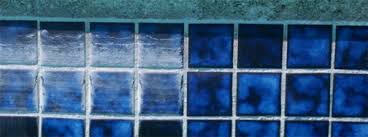
Calcium Hardness
Dissolved calcium is invisible unless the pH rises higher than 8.0. The calcium dissolved in water is called calcium hardness. Soft water refers to water with lesser or no levels of calcium. (Think of your water softener at home). Calcium becomes unstable at very high levels and become even more unstable if the pH or the total alkalinity rise above the normal levels. These imbalances can result in cloudy water and/or scale.
As water temperature rises, calcium becomes more likely to precipitate out of solution. Calcium is actually more soluble in cold water. (Think of the white calcium deposits inside of a tea kettle).
Too soft water is aggressive and will actually remove calcium from plaster in concrete pools in order to satisfy its need for the mineral. If the pool is vinyl or fiberglass, the low calcium water will attack metal fittings and heat exchangers resulting in destruction of the fittings or pinhole leaks in the heater. Salt water pools, with too soft water, are often subject to corrosion. When such corrosion occurs, it is also common for stains to appear on pool surfaces. These stains are mistakenly blamed on metals in the water such as iron or copper when, in fact, it was the hardness of the water.
Calcium content is best in the range of 100-400 ppm, but higher levels can be tolerated when properly managed. The safest and most reliable way to reduce the calcium of your pool is to remove and add fresh water back into your pool. If you have a pool pump and filter that has a backwash option, you can use the occasional backwashing you have to to anyway as an opportunity to remove a little extra pool water and refill the pool with fresh water. (Otherwise set your filter to “waste”). Here are a few general instructions on backwashing and refilling your pool:
- First test your pool calcium hardness level. You need to first know how your current calcium hardness level.
- Determine how much water you need to remove from your pool. If you are over the ideal calcium hardness range (400 ppm), you may need to drain about one-fourth of your pool to bring the level down. This can be an expensive undertaking if your local water rates are high, so you should talk to a local pool service provider first to see what is typically done in your area. They have experience with this and can give a rough estimation of how much water to drain to avoid unnecessary draining, but make sure you drain enough to affect the calcium hardness level.
- Drain a portion of your swimming pool water, either by backwashing or siphoning the water. You can siphon water out of your pool if your pool is above ground or the ground behind the pool slopes enough away. Be sure to turn off your pool pump if you siphon the water and expect the pool water level to go below the pump water inlet. You do not want the pump motor to be running without any water flowing through it.
- Refill the water you have drained. Wait at least six hours for the fresh and existing water to mix together, as the cold source water might have sunk to the bottom of the pool if your existing pool water is warm.
- Retest your pool water for calcium hardness and determine if you are within the ideal range, or if you need to lower the calcium hardness level again.
Another, or additional way to reduce calcium levels is adding flocculants, that can help attract minerals that have gone out of solution, where your water is very hard. Calcium that is dissolved in the water, or in-solution, likely will not be affected by the flocculant. Flocs really only cause solids already out-of-solution to stick together, so that they can be vacuumed or filtered out of the pool water. In this case, you may can:
- Use a flocculant to rid the pool of free-floating calcium carbonate.
- Vacuum the walls and floors of the pool, so the excess calcium carbonate particles are pulled into the pool filter.
- Backwash or clean out your pump filter.
- Drain a portion of your pool water and refill with fresh water.
- Test the pool water for calcium hardness. With the excess calcium carbonate removed and fresh water added, you can should notice a reduced calcium hardness level.
Finally, in cases where it may be difficult to reduce calcium hardness, it is possible to control it so that a potential problem such as cloudy water or scale formation is prevented. The best way to minimize the effect of high calcium levels is through the use of a sequestering agent. A sequestering agent is a compound that, when added to water, will chemically bond with calcium and other minerals such as magnesium, to make them, (in a sense), more soluble. This means that calcium will still be present, but in a form that is less likely to cloud water or form scale if the pH or other factors get out of balance. In addition, since calcium will still be in the water, you will not have the corrosion problems you would otherwise experience with soft water. A further advantage is that elevated levels of calcium (over 400 ppm) can be tolerated without constant need for dilution. This becomes especially important when the pool is located in hard water areas or calcium-based chlorine sources are used.